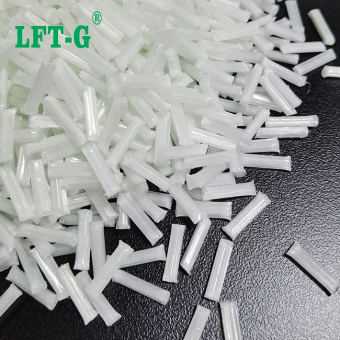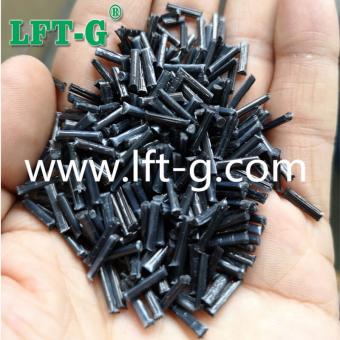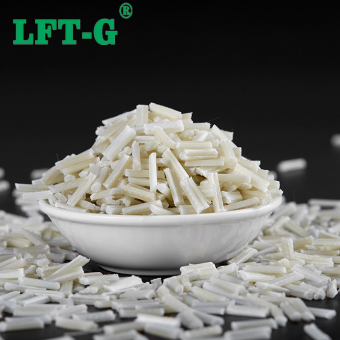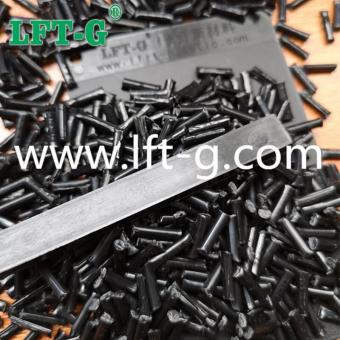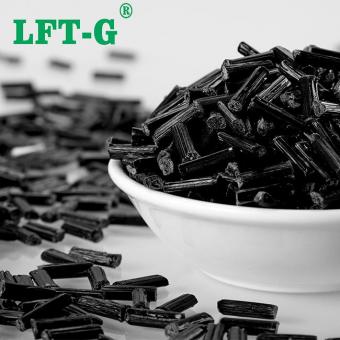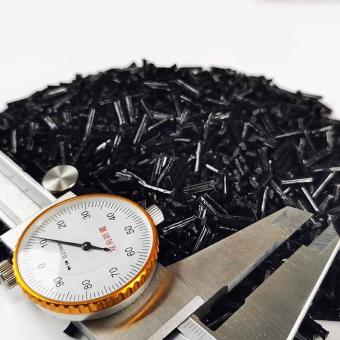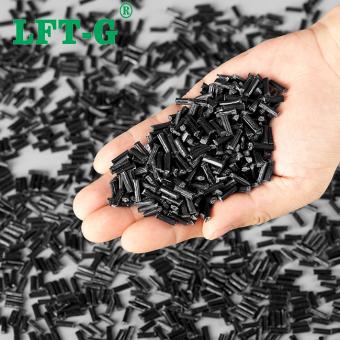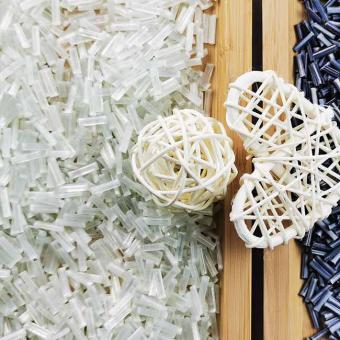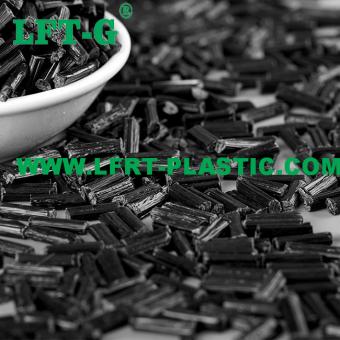-
LFT-G PP compunds filling long glass fiber polymers high rigidity low warpage instead metal for home appliance partsPP-LGF compounds Long glass fiber reinforced polypropylene composites belong to a kind of long glass fiber reinforced thermoplastics, the main preparation materials are continuous long glass fiber and polypropylene. and polypropylene. Long glass fiber reinforced polypropylene composites have longer glass fiber length, high strength, low density, high impact performance, its rigidity, strength, creep and other properties better than conventional fiber reinforced polypropylene composites. The role of glass fiber reinforced materials in glass fiber reinforced polypropylene composites is to carry loads, and the specific load-bearing properties are related to the proportion of glass fiber reinforced materials in the material, length, orientation and other factors. In the preparation process, it is found that, under the condition of unchanged preparation technology, the increase of the proportion of glass fiber reinforced material in the material will shorten the length of the material, and the bending property, tensile property, and strength of the material will be increased; when the proportion reaches 50%, the various mechanical properties of the material will reach the best. PP-LGF application In automotive engineering, instrument panels, front-end components and underbody elements are increasingly made of glass-fiber-reinforced polypropylene. Polypropylene is characterized by low density, low material costs and ease of reuse, and is therefore gradually replacing engineering plastics and metals in these applications. Glass fiber reinforced composites can significantly enhance the durability, rigidity, toughness, creep, etc. of the original material, the current glass fiber reinforced composites are increasingly widely used in automotive parts.LGF polypropylene composites can solve the traditional short glass fiber reinforced materials are easy to warp, poor low-temperature toughness, fatigue resistance is generally shortcomings such as LGF polypropylene composites, LGF polypropylene composites in the glass fiber retention length is longer, with a high specific strength, LGF polypropylene composites have longer retained glass fiber length, high specific strength, high specific modulus, strong impact resistance, dimensional stability and low warpage, etc. Therefore, LGF polypropylene materials are used to replace parts produced by traditional PA-SGF, PBT-SGF and other materials. Further weight and cost reductions are realized. LGF polypropylene can be used for engine hoods, front-end modules, instrument panel frames, tailgates, battery trays, and door liner modules. Datasheet for reference Details Grade Fiber specification Mian characteristics Applications General grade 30%-60% Chemical coupling,high strength Automobile parts, washing machine parts, water pump parts, water treatment parts, furniture, etc. Heat-resistance grade 30%-60% High strength, long-term heat aging resistance Automobile front and rear end modules, water tank frames, battery brackets, hood covers, sunroof frames, etc. UV-resistance grade 30%-60% High strength, UV resistance, long term heat aging resistance, good product appearance Car (truck) door handles, mirror systems, battery housings, truck (SUV) exterior pedals, etc. Toughten resistance grade 30%-60% Ultra-high impact strength (at normal and low temperatures) Power tools, pump housings, pipe fittings, etc. Other materials you may wonder PA6-LGF TPU-LGF PA12-LGF Frequently asked questions Q. Does long glass fiber and long carbon fiber injection have special requirements for injection molding machines and molds? A. There are certainly requirements. Especially from the product design structure, as well as the injection molding machine screw nozzle and mold structure injection molding process must consider the requirements of long fiber. Q. Using a long fiber reinforced thermoplastic material, will it block the die hole due to the long length of the fiber or not? A. When using long glass fiber or long carbon fiber, it is necessary to evaluate whether the product is suitable for LFT-G. If the product is too small or the dispensing is not suitable for long fiber materials. The long fiber itself has requirements for the mold nozzle. Q. How to choose the reinforcement method and length of the material when using long fiber reinforced thermoplastic material? A. The selection of materials depend on the requirements of the products. It is necessary to assess how much the content is enhanced and how much length is more appropriate, which are depending on the performance requirements of the products.
- Polypropylene filled lgf 30 40 50
- reinforced pp virgin grade plastic
- Low warpage electronic appliance
- PP recycled for car parts electric parts
- PP composite pellets Polymer granules
- thermoplastic resin PP with fiber
Tags :
-
Lft-g PA12 raw material filled long carbon fiber new plastic higher performance original color sample freePolyamide 12 material Polyamide (PA), commonly known as nylon, is a diverse group of polymers that are used as engineering plastics to replace metals to meet downstream industrial requirements for lightweight, low-cost products. The materials of the polyamide series exhibit resistance to high temperatures and electrical resistance. Due to their crystalline structure, they also show excellent chemical resistance. They have very good mechanical and barrier properties. In addition, these materials are very flame retardant. Polyamides were the first truly commercial synthetic fibers. When reinforced with carbon fibers (staple or long), their stiffness can compete with that of metals, which is why polyamides are often considered in metal replacement projects. Polyamides are widely used in the automotive, transportation, electronics, electrical, and consumer goods markets. Main properties of PA12: Excellent chemical resistance Low temperature impact resistance Aging resistance High temperature resistance Even if they do not excel in temperature resistance (HDT, peak temperature...) they show stable performance over time even if they do not excel in terms of temperature resistance (HDT, peak temperature...) Their excellent durability allows them to be used in a wide range of conditions (temperature, pressure, chemical ......) PA12 is particularly suitable for situations where long-term stability is required. Application More application fields you can contact us for technical advice. Details Number Color Length Sample Package MOQ Port of Loading Delivery time PA12-NA-LCF Natural color/Customized 6-25mm Available 20kg/bag 20kg Xiamen Port 7-45 days after shipment Produce processing Tests Contact us for more materials
- pa12 lcf pallets black
- Long carbon fiber Reinforced Polyamide12 for electrial accessories
- automotive parts materials PA12
- thermoplastic resin pa12 with fiber
- Nylon 12 composite pellets Polymer granules
Tags :
-
lft-g PBT modified plastic filling long fiber high performance natural color industrial use injection moldedPBT materials Polybutylene terephathalate (PBT) is a crystalline thermoplastic engineering plastic made by polymerizing dimethyl terephthalate (DMT) and 1,4 butanediol (1,4-Butanediol). Due to the growth of the -CH2- chain of PBT resin, the molecular chain is easy to flex, so the glass transfer temperature is lower than that of PET, and the crystallization speed increases. PBT can also be called thermoplastic polyester plastics, applicable to different processing industries, generally more or less will add additives, or blended with other plastics, with different proportions of additives, can be manufactured with different specifications of the product. Because PBT has heat resistance, weather resistance, chemical resistance, good electrical properties, low water absorption, good gloss, widely used in electronic and electrical appliances, automotive parts, machinery, household goods, etc.. PBT's downstream applications include the automotive, electronics/electrical appliance, and machinery industries. Datasheet for reference Application LGF & SGF Advantages of Long glass fiber reinforced materials Glass fiber reinforced plastic is based on the original pure plastic, adding glass fibers and other additives, so as to improve the scope of use of the material. Generally speaking, most of the glass fiber reinforced materials are used in the structural parts of the products, which is a kind of structural engineering materials, such as: PP, ABS, PA66, PA6, PC, POM, PPO, PET, PBT, PPS and so on. Advantages After glass fiber reinforcement, glass fiber is a high temperature resistant material, therefore, the heat-resistant temperature of reinforced plastics is much higher than before without glass fiber, especially nylon plastics. After glass fiber reinforcement, due to the addition of glass fiber, it restricts the mutual movement of the polymer chain of the plastic, therefore, the shrinkage of the reinforced plastic decreases a lot and the rigidity is greatly improved. After glass fiber reinforced, the reinforced plastic will not stress cracking, at the same time, the impact resistance of the plastic improves a lot. After the glass fiber reinforcement, the glass fiber is a high strength material, which also greatly improves the strength of the plastic, such as: tensile strength, compression strength, bending strength, improve a lot. After glass fiber reinforcement, due to the addition of glass fiber and other additives, the combustion performance of the reinforced plastics decreases a lot, most of the materials can not be ignited, it is a kind of flame-retardant material. Warehouse & Lab Customers & Us Catalog
- pbt recycle long fiber granules
- PBT pellets lgf 30 polymer
- LFT materials PBT green materials
- 12mm pellets pbt high toughness
- made in China high performance PBT
Tags :
-
Xiamen LFT-G Polyamide66 LCF filled wear resistance for auto partsPhysical properties of nylon materials Excellent mechanical properties: high mechanical strength, good toughness. Excellent self-wetting, wear resistance: small coefficient of friction, long service life as a transmission component. Excellent heat resistance: PA66 heat distortion temperature is very high, can be used for a long time at 150 degrees Celsius, PA66 after glass fiber reinforced, the heat distortion temperature of 252 degrees Celsius or more. Excellent electrical insulation properties: its volume resistance is very high, high breakdown voltage resistance, is an excellent electrical/electronic insulation materials. Introduction of Nylon66 filled LCF pellets PA66 is a high-performance engineering plastics, moisture absorption, poor dimensional stability of products, strength and hardness and metal. In order to overcome these shortcomings, as early as the 1970s, people use carbon fiber and glass fiber to enhance to improve its performance. PA66 reinforced with carbon fiber fiber materials in recent years the development of faster, because PA66 and carbon fiber are excellent performance in the field of engineering plastics materials, the composite material comprehensive embodiment of the superiority of the two, such as strength and rigidity than the unenhanced PA66 is much higher than that of the high-temperature creep is small, the thermal stability of a significant improvement in the dimensional accuracy of the good, wear-resistant. At present, PA66 carbon fiber composite materials are mainly short-cut or long carbon fiber reinforced particles, has been widely used in the automotive industry, sporting goods, textile machinery, aerospace materials and other fields. Carbon fiber is lightweight, high tensile strength, abrasion resistance, corrosion resistance, creep resistance, electrical conductivity, heat transfer, etc. It is very similar to glass fiber, but superior to glass fiber. Compared with glass fiber, the modulus is 3 times higher, which is a material with high rigidity and high strength. Datasheet of PA6-LCF for reference From the experiments of the technical department, we know that the bending strength, bending modulus of elasticity, impact strength and plane shear strength of the carbon fiber PA66 fiber-added material increase with the increase of carbon fiber content, transverse shear strength slightly decreased, overall the strength of the material has increased dramatically. Application of PA66-LCF Certificate Quality Management System ISO9001/16949 Certification National Laboratory Accreditation Certificate Modified Plastics Innovation Enterprise Honorary Certificate Heavy metal REACH & ROHS testing Factory & Lab Q & A 1. Is there a unified reference data for carbon fiber product performance? The performance of specific carbon fiber filaments is fixed, such as Toray's carbon fiber filaments, T300, T300J, T400, T700 and so on, there are a series of parameters can be traced. However, there is no uniform standard to measure the carbon fiber composite products. Firstly, the different types of raw materials selected will lead to different performance of the products, and then due to the choice of matrix and the different design of the products, it will lead to different performance of the products. In addition to some common carbon fiber tubes, carbon fiber boards and other conventional parts, most of the carbon fiber products in the production of the sample before the test to determine whether the performance of the product is in line with the use of the expected standard, and as a base point, so as to carry out the production and use of large quantities. 2. Are carbon fiber composite products expensive? The price of carbon fiber composite products is closely related to the price of raw materials, the level of technology and the quantity of products. Some products of the industrial environment requirements are high, the performance of carbon fiber products and materials have special requirements, which requires the selection of specific raw materials, raw materials, the higher the performance of the natural price of the more expensive, such as the application of orthopedic carbon fiber PEEK thermoplastic materials. Of course, the more complex the production process, the greater the working time and workload, and the production cost increases. However, the larger the order quantity, the lower the cost per piece, once the mass production of a particular carbon fiber product has been established. In the long run, the superior performance of carbon fiber will prolong the service life of the product, reduce the number of maintenance, and is also very beneficial to the reduction of the cost of use. 3. Are carbon fiber composite products toxic? Carbon fiber composites are made of carbon fiber filaments mixed with ceramics, resins, metals and other matrices, generally not toxic. For example, the above mentioned PEEK material is a food grade resin, this material has good compatibility...
- PA66 plastic raw materials injection molded
- PA66 recycled pure pellets
- long carbon fiber pa66 natural black color
- pa66 lcf granules instead metal polymers
- auto part and aerospace parts
Tags :
-
Xiamen LFT-G Copo Polypropylene filling LGF 20-60 injection molded reinforced PlasticAbout LFT materials Long-fiber thermoplastics (LFTs) have long been used in the automotive industry, especially in products based on polypropylene (PP materials), which offer light weight, strength and design freedom to replace metals in certain structural applications. LFT compounds have excellent mechanical properties and are therefore well suited for metal replacement and lightweighting, thereby reducing carbon footprints. Automotive, transportation and industrial are the main markets for LFT materials, where weight reduction is the main objective. The extremely high mechanical properties of Long fiebr compounds become better compared to the same formulations with short fibers. For example, the impact of energy impact absorption is two to three times higher. While LFT is still a more expensive material option than short fiber compounds, the combination of great performance gains and sustainability will be attractive to many end users. About the Long glass fiber Long carbon fiber composites is one kind of long fiber reinforced composites, which is a new type of fiber material with high strength and high modulus fiber.LCF carbon fiber composites show high strength along the fiber axis direction, and have the characteristics of high strength, light weight, etc., and have a full range of mechanical properties such as density, specific strength, specific modulus and so on, which are incomparable with other materials, and it is a new material with excellent mechanical properties and a lot of special It is a new material with excellent mechanical properties and many special functions. Advantages Corrosion resistance: LCF carbon fiber composite material has good corrosion resistance and can adapt to the harsh working environment. UV resistance: strong ability to resist ultraviolet rays, the products are less problematic to be harmed by ultraviolet rays. Abrasion and impact resistance: the advantages are more obvious than general materials; and Low density: lower density than many metal materials, to achieve the purpose of lightweight. Other properties: such as reducing warpage, improving rigidity, impact modification, increasing toughness, electrical conductivity and so on. LCF carbon fiber composites have higher strength, higher rigidity, lower weight, and excellent electrical conductivity compared to glass fiber. Datasheet of PP-LCF Application Processing About us
- PPS long carbon fiber extrusion
- LFT materials PP green materials
- customized pps made in China
- car parts automotive parts lgfrp materials
- can be recycled pp raw materials lft
Tags :
-
Xiamen LFT Polylactic Acid compounds fill carbon fiber high performance natural colorWhat is carbon fiber PLA? Carbon fiber reinforced PLA is an excellent material, strong, lightweight, with excellent layer bonding and low warpage. It has excellent layer adhesion and low warpage. Carbon fiber filaments are not as strong" as other 3D materials, but are much stiffer. The increased rigidity of carbon fiber means increased structural support, but reduced overall flexibility. It is slightly more brittle than regular PLA. Carbon PLA Specifications Flexural strength: 57 MPa Melting temperature: 190°C- 230°C Tensile strength: 45.5 MPa . Elongation at break: (73°F) 320% Standard tolerance: 0.05mm Layer thickness: 3mm Shore hardness: 45D Density: 1.3 g/cm3 (1300 kg/m3) Heat distortion: 21% to 85°C Shrinkage: very low when cooled to higher ambient temperatures Characteristics Moderate strain at break (8-10%), so the filaments are not very brittle, but very tough Very high melt strength and viscosity Good dimensional accuracy and stability Easy handling on many platforms Highly attractive matte black surface Excellent impact resistance and lightness Applications of carbon fiber PL A material Carbon PLA is the ideal material for frames, supports, housings, propellers, chemical instruments, etc. It is also particularly preferred by drone manufacturers and RC enthusiasts. Ideal for applications requiring maximum stiffness and strength. Other products you may wonder PA6-LCF PP-LCF PEEK-LCF About Long carbon fiber Long carbon fiber reinforced composites offer siginifacant weight savings and provide optimum strength and stiffness properties in reinforced thermoplastics. The excellent machanical properties of long carbon fiber reinforced composites make it an ideal replacement for metals. Combined with the design and manufacturing advantages of injection molded thermoplastics, long carbon fiber composites simplify the re-imagining of components and equipment with demanding performance requirements. Its widespread use in aerospace and other advanced industries makes it a "high-tech" perception of consumers - you can use it to market products and create differentiation from competitors. About us Xiamen LFT composite plastic Co., Ltd is a brand-name company that focuses on LFT&LFRT. Long Glass Fiber Series (LGF) & Long Carbon Fiber Series (LCF). The company's thermoplastic LFT can be used for LFT-G injection molding and extrusion, and can also be used for LFT-D molding. It can be produced according to customer requirements: 5~25mm in length. The company's continuous infiltration reinforced thermoplastics have passed ISO9001&16949 system certification, and the products have obtained lots of national trademarks and patents. We can offer you: 1. LFT & LFRT material technical parameters and leading edge design. 2. Mold front design and recommendations. 3. Provide technical support such as injection molding and extrusion molding.
- PLA pellets lcf 30 polymer Polylactic Acid
- high strength and high toughness reinforced pla pellets
- plastic pla lcf30 producer whole sell pla
- best long carbon fiber pla lcf30 granules
- pla cf20 pla granule price on stock
Tags :
-
Xiamen LFT-G Homopolymer Polypropylene fill Long carbon fiber injection molding high toughnessWhat is the Homo PP? Homopolymerized PP plastics are made by polymerizing a single propylene monomer and do not contain ethylene monomer in the molecular chain. Homopolymerized polypropylene pp plastic has the advantage of better strength. Disadvantages are poor impact resistance (more brittle), poor toughness, poor dimensional stability, easy aging, and poor long-term heat stability performance. PP as a thermoplastic polymer began commercial production in 1957, is the first of the regulated stand-alone polymers. Its historical significance is further reflected in the fact that it has been the fastest growing major thermoplastic and has a very wide range of applications within the thermoplastic field, especially in fiber and filament, film extrusion, and injection molding processes. HPP-LCF Long carbon fiber reinforced composites offer significant weight savings and provide optimum strength and stiffness properties in reinforced thermoplastics. The excellent mechanical properties of long carbon fiber reinforced composites make it an ideal replacement for metals. Combined with the design and manufacturing advantages of injection molded thermoplastics, long carbon fiber composites simplify the re-imagining of components and equipment with demanding performance requirements. Its widespread use in aerospace and other advanced industries makes it a "high-tech" perception of consumers - you can use it to market products and create differentiation from competitors. Application You can contact us for more detailed information about application Datasheet for your reference Short fiber VS Long fiber Long carbon fiber Xiamen LFT composite plastic Co., Ltd Xiamen LFT composite plastic Co., Ltd is a brand-name company that focuses on LFT&LFRT. Long Glass Fiber Series (LGF) & Long Carbon Fiber Series (LCF). The company's thermoplastic LFT can be used for LFT-G injection molding and extrusion, and can also be used for LFT-D molding. It can be produced according to customer requirements: 5~25mm in length. The company's continuous infiltration reinforced thermoplastics have passed ISO9001&16949 system certification, and the products have obtained lots of national trademarks and patents.
- self owing PP pellets
- high strength and high toughness reinforced pp pellets
- pp cf40 for electrical connector price
- superior waterproof pp granules
- reinforced Polypropylene PP virgin pure materials
Tags :
-
Xiamen LFT Thermoplastic Polyurethane resin filling long glass fiber engineering plastics high strengthTPU introduction Thermoplastic polyurethane (TPU) elastomers are linear polymers formed by the copolymerization of hard and soft chain segments, which have physical properties such as tensile, abrasion and heat resistance, and elasticity similar to rubber. Thanks to the excellent product performance, the application fields of TPU are expanding, including daily consumer goods, construction, medical, military, automotive, agriculture and many other fields. New products and applications are also emerging, such as large-diameter hoses (shale gas extraction), charging cables for new energy vehicles, foamed TPU (ETPU) sports shoes midsoles prepared by supercritical foaming process, invisible braces, etc. Fiber reinforced modified TPU composites TPU has good impact resistance, but in some applications, high modulus of elasticity and very hard material is required. Glass fiber reinforced modification is a common technical means to improve the elastic modulus of the material. Through modification, thermoplastic composites with many advantages such as high elastic modulus, good insulation, heat resistance, good elastic recovery, good corrosion resistance, impact resistance, low coefficient of expansion and dimensional stability can be obtained. Long glass fiber VS Short glass fiber Compared with the short fiber, long fiber has more excellent performance in mechanical properties. It is more suitable for large products and structural parts. It has 1-3 times higher toughness than short fiber, and the tensile strength is increased by 0.5-1 times. Thermoplastics VS Thermosets Thermosets: when heated for the first time, they can soften and flow, and when heated to a certain temperature, they produce a chemical reaction a cross-chain curing and become hard, this change is irreversible, after that, when heated again, they can no longer become soft and flow. Thermoplastic: thermoplastic resin is the main component, and various additives are added to form a plastic. Under certain temperature conditions, plastic can be softened or melted into any shape, and the shape remains unchanged after cooling; this state can be repeated many times and always has plasticity, and this repeated is only a physical change. Advantages Thermosets: Thermoset plastics retain their strength and shape even when heated. This makes thermoset plastics ideal for producing permanent parts and large, strong shapes. In addition, these parts have excellent strength properties (despite their fragility) and do not lose significant strength when exposed to higher operating temperatures. Thermoplastics: Thermoplastics are the most widely used plastics and typically have high chemical and thermal resistance, as well as a high strength structure that is not easily deformed. It is made of thermoplastic resin as the main component with various additives. Thermoplastic products have excellent electrical insulation, with very low dielectric constant and dielectric loss, suitable for high Frequency and high voltage insulation materials. TPU-LGF applications TDS for TPU-LGF Products details Number Length Colour Sample Price MOQ Package Delivery time TPU-NA-LGF30 12mm (can be customized) Natural colour (can be customized) Available Need to be confirmed 25kg 25kg/bag 7-15 days after shipment About us Company Xiamen LFT composite plastic Co., Ltd. is a brand-name company that focuses on LFT&LFRT. Long Glass Fiber Series (LGF) & Long Carbon Fiber Series (LCF). The company's thermoplastic LFT can be used for LFT-G injection molding and extrusion, and can also be used for LFT-D molding. It can be produced according to customer requirements: 5~25mm in length. The company's long-fiber continuous infiltration reinforced thermoplastics have passed ISO9001 &16949 system certification, and the products have obtained lots of national trademarks and patents.
- tpu lgf30 for toe cap enhanced
- self owing tpu pellets instead metal
- tpu different resin lgf reinforced materials
- high strength and high toughness reinforced tpu pellets
- self owing tpu pellets polymer
Tags :
-
LFT-G PPS Polyphenylene sulfide with long carbon fiber thermoplastic resin high rigidity and strengthPPS Information Polyphenylene sulfide (PPS) is not enhanced before modification, its disadvantages are brittle, poor toughness, low impact strength, after filling glass fiber, carbon fiber and other enhancements modified to overcome the above shortcomings, to obtain very good overall performance. PPS filling Long carbon fiber In the modified engineering plastics industry, long fiber reinforced composites are composites made from long carbon fibers, long glass fibers and polymer matrix through a series of special modification methods. The most important feature of long fiber composites is that they have superior performance that the original materials do not have. If we classify them according to the length of the reinforcing materials added, they can be divided into: long fiber, short fiber and continuous fiber composites. Long carbon fiber composites are one kind of long fiber reinforced composites, which are a new fiber material with high strength and high modulus. It is a new material with excellent mechanical properties and many special functions. Corrosion resistance: LCF carbon fiber composite materials have good corrosion resistance and can adapt to the harsh working environment. UV resistance: the ability to resist UV is strong, and the products are less damaged by UV. Abrasion and impact resistance: the advantage of comparing with general materials is more obvious. Low density: lower density than many metal materials, can achieve the purpose of light weight. Other properties: such as reducing warpage, improving rigidity, impact modification, increasing toughness, electrical conductivity, etc. LCF carbon fiber composites have higher strength, higher rigidity, lower weight, and excellent electrical conductivity compared with glass fiber. PPS TDS for reference PPS Application Other products you can also contact us for more technical advice. Q&A 1. Are carbon fiber composite products very expensive? The price of carbon fiber composite products is closely related to the price of raw materials, the level of technology and the number of products. The higher the performance of the raw material, the more expensive it is, such as the carbon fiber PEEK thermoplastic material used in orthopedics. Of course, the more complex the manufacturing process, the greater the working time and workload, and the increased production costs. However, the larger the order quantity, the lower the cost per product. In the long run, the superior performance of carbon fiber will extend the life of the product, reduce the number of maintenance, and is also very beneficial to reduce the cost of use. 2. Are carbon fiber composite products toxic? Carbon fiber composites are made of carbon fiber filaments mixed with ceramics, resins, metals and other substrates, and are generally not toxic. For example, the above-mentioned PEEK material is made of food-grade resin, which is very compatible with the human body and is not only harmless to humans, but also becomes a more ideal material for orthopedic surgery because of its high strength and elastic modulus close to the bone cortex. Carbon fiber medical bed plate, will be in daily contact with many patients body, will not have adverse effects on the human body, on the contrary, for the accuracy of medical diagnosis and a great help. 3. What is the difference between thermosetting carbon fiber composites and thermoplastic carbon fiber composites? Thermoset carbon fiber composites favor the role of curing agent in curing and molding. While thermoplastic carbon fiber composite products mainly rely on cooling down to achieve the shaping. Thermoplastic carbon fiber composites are not as popular as thermoset carbon fiber composites, mainly because they are expensive and are generally used in high-end industries. Thermoset carbon fiber composites are difficult to recycle due to the limitation of the resin matrix itself, and are generally not considered; thermoplastic carbon fiber composites can be recycled, and can be made twice as long as they are heated to a certain temperature. About us We will offer you: 1. LFT & LFRT material technical parameters and leading edge design 2. Mold front design and recommendations 3. Provide technical support such as injection molding and extrusion molding
- PPS polyphenylent with addition and filler
- pps lcf40 granules raw material
- pps LCf40 plastic injection part
- carbon fibre reinforced pps lcf pellet
Tags :
-
Xiamen LFT-G Polyamide 66 Long Carbon Fiber filled wear resistance for auto partsPhysical properties of nylon materials Excellent mechanical properties: high mechanical strength, good toughness. Excellent self-wetting, wear resistance: small coefficient of friction, long service life as a transmission component. Excellent heat resistance: PA66 heat distortion temperature is very high, can be used for a long time at 150 degrees Celsius, PA66 after glass fiber reinforced, the heat distortion temperature of 252 degrees Celsius or more. Excellent electrical insulation properties: its volume resistance is very high, high breakdown voltage resistance, is an excellent electrical/electronic insulation materials. Introduction of Nylon66 filled LCF pellets PA66 is a high-performance engineering plastics, moisture absorption, poor dimensional stability of products, strength and hardness and metal. In order to overcome these shortcomings, as early as the 1970s, people use carbon fiber and glass fiber to enhance to improve its performance. PA66 reinforced with carbon fiber fiber materials in recent years the development of faster, because PA66 and carbon fiber are excellent performance in the field of engineering plastics materials, the composite material comprehensive embodiment of the superiority of the two, such as strength and rigidity than the unenhanced PA66 is much higher than that of the high-temperature creep is small, the thermal stability of a significant improvement in the dimensional accuracy of the good, wear-resistant. At present, PA66 carbon fiber composite materials are mainly short-cut or long carbon fiber reinforced particles, has been widely used in the automotive industry, sporting goods, textile machinery, aerospace materials and other fields. Carbon fiber is lightweight, high tensile strength, abrasion resistance, corrosion resistance, creep resistance, electrical conductivity, heat transfer, etc. It is very similar to glass fiber, but superior to glass fiber. Compared with glass fiber, the modulus is 3 times higher, which is a material with high rigidity and high strength. Datasheet of PA6-LCF for reference From the experiments of the technical department, we know that the bending strength, bending modulus of elasticity, impact strength and plane shear strength of the carbon fiber PA66 fiber-added material increase with the increase of carbon fiber content, transverse shear strength slightly decreased, overall the strength of the material has increased dramatically. Application of PA66-LCF Certificate Quality Management System ISO9001/16949 Certification National Laboratory Accreditation Certificate Modified Plastics Innovation Enterprise Honorary Certificate Heavy metal REACH & ROHS testing Factory & Lab Q & A 1. Is there a unified reference data for carbon fiber product performance? The performance of specific carbon fiber filaments is fixed, such as Toray's carbon fiber filaments, T300, T300J, T400, T700 and so on, there are a series of parameters can be traced. However, there is no uniform standard to measure the carbon fiber composite products. Firstly, the different types of raw materials selected will lead to different performance of the products, and then due to the choice of matrix and the different design of the products, it will lead to different performance of the products. In addition to some common carbon fiber tubes, carbon fiber boards and other conventional parts, most of the carbon fiber products in the production of the sample before the test to determine whether the performance of the product is in line with the use of the expected standard, and as a base point, so as to carry out the production and use of large quantities. 2. Are carbon fiber composite products expensive? The price of carbon fiber composite products is closely related to the price of raw materials, the level of technology and the quantity of products. Some products of the industrial environment requirements are high, the performance of carbon fiber products and materials have special requirements, which requires the selection of specific raw materials, raw materials, the higher the performance of the natural price of the more expensive, such as the application of orthopedic carbon fiber PEEK thermoplastic materials. Of course, the more complex the production process, the greater the working time and workload, and the production cost increases. However, the larger the order quantity, the lower the cost per piece, once the mass production of a particular carbon fiber product has been established. In the long run, the superior performance of carbon fiber will prolong the service life of the product, reduce the number of maintenance, and is also very beneficial to the reduction of the cost of use. 3. Are carbon fiber composite products toxic? Carbon fiber composites are made of carbon fiber filaments mixed with ceramics, resins, metals and other matrices, generally not toxic. For example, the above mentioned PEEK material is a food grade resin, this material has good compatibility...view more
-
LFT-G Polyphenylene Sulfide composite long carbon fiber thermoplastic resin high rigidity and strengthPPS Information Polyphenylene sulfide (PPS) is not enhanced before modification, its disadvantages are brittle, poor toughness, low impact strength, after filling glass fiber, carbon fiber and other enhancements modified to overcome the above shortcomings, to obtain very good overall performance. PPS filling Long carbon fiber In the modified engineering plastics industry, long fiber reinforced composites are composites made from long carbon fibers, long glass fibers and polymer matrix through a series of special modification methods. The most important feature of long fiber composites is that they have superior performance that the original materials do not have. If we classify them according to the length of the reinforcing materials added, they can be divided into: long fiber, short fiber and continuous fiber composites. Long carbon fiber composites are one kind of long fiber reinforced composites, which are a new fiber material with high strength and high modulus. It is a new material with excellent mechanical properties and many special functions. Corrosion resistance: LCF carbon fiber composite materials have good corrosion resistance and can adapt to the harsh working environment. UV resistance: the ability to resist UV is strong, and the products are less damaged by UV. Abrasion and impact resistance: the advantage of comparing with general materials is more obvious. Low density: lower density than many metal materials, can achieve the purpose of light weight. Other properties: such as reducing warpage, improving rigidity, impact modification, increasing toughness, electrical conductivity, etc. LCF carbon fiber composites have higher strength, higher rigidity, lower weight, and excellent electrical conductivity compared with glass fiber. PPS TDS for reference PPS Application Other products you can also contact us for more technical advice. Q&A 1. Are carbon fiber composite products very expensive? The price of carbon fiber composite products is closely related to the price of raw materials, the level of technology and the number of products. The higher the performance of the raw material, the more expensive it is, such as the carbon fiber PEEK thermoplastic material used in orthopedics. Of course, the more complex the manufacturing process, the greater the working time and workload, and the increased production costs. However, the larger the order quantity, the lower the cost per product. In the long run, the superior performance of carbon fiber will extend the life of the product, reduce the number of maintenance, and is also very beneficial to reduce the cost of use. 2. Are carbon fiber composite products toxic? Carbon fiber composites are made of carbon fiber filaments mixed with ceramics, resins, metals and other substrates, and are generally not toxic. For example, the above-mentioned PEEK material is made of food-grade resin, which is very compatible with the human body and is not only harmless to humans, but also becomes a more ideal material for orthopedic surgery because of its high strength and elastic modulus close to the bone cortex. Carbon fiber medical bed plate, will be in daily contact with many patients body, will not have adverse effects on the human body, on the contrary, for the accuracy of medical diagnosis and a great help. 3. What is the difference between thermosetting carbon fiber composites and thermoplastic carbon fiber composites? Thermoset carbon fiber composites favor the role of curing agent in curing and molding. While thermoplastic carbon fiber composite products mainly rely on cooling down to achieve the shaping. Thermoplastic carbon fiber composites are not as popular as thermoset carbon fiber composites, mainly because they are expensive and are generally used in high-end industries. Thermoset carbon fiber composites are difficult to recycle due to the limitation of the resin matrix itself, and are generally not considered; thermoplastic carbon fiber composites can be recycled, and can be made twice as long as they are heated to a certain temperature. About us We will offer you: 1. LFT & LFRT material technical parameters and leading edge design 2. Mold front design and recommendations 3. Provide technical support such as injection molding and extrusion molding
- PPS polyphenylent
Tags :
-
LFT-G Polyphenylene Sulfide Composites Long Carbon Fiber Reinforced resinPPS Information Polyphenylene sulfide (PPS) is not enhanced before modification, its disadvantages are brittle, poor toughness, low impact strength, after filling glass fiber, carbon fiber and other enhancements modified to overcome the above shortcomings, to obtain very good overall performance. PPS filling Long carbon fiber In the modified engineering plastics industry, long fiber reinforced composites are composites made from long carbon fibers, long glass fibers and polymer matrix through a series of special modification methods. The most important feature of long fiber composites is that they have superior performance that the original materials do not have. If we classify them according to the length of the reinforcing materials added, they can be divided into: long fiber, short fiber and continuous fiber composites. Long carbon fiber composites are one kind of long fiber reinforced composites, which are a new fiber material with high strength and high modulus. It is a new material with excellent mechanical properties and many special functions. Corrosion resistance: LCF carbon fiber composite materials have good corrosion resistance and can adapt to the harsh working environment. UV resistance: the ability to resist UV is strong, and the products are less damaged by UV. Abrasion and impact resistance: the advantage of comparing with general materials is more obvious. Low density: lower density than many metal materials, can achieve the purpose of light weight. Other properties: such as reducing warpage, improving rigidity, impact modification, increasing toughness, electrical conductivity, etc. LCF carbon fiber composites have higher strength, higher rigidity, lower weight, and excellent electrical conductivity compared with glass fiber. PPS TDS for reference PPS Application Other products you can also contact us for more technical advice. Q&A 1. Are carbon fiber composite products very expensive? The price of carbon fiber composite products is closely related to the price of raw materials, the level of technology and the number of products. The higher the performance of the raw material, the more expensive it is, such as the carbon fiber PEEK thermoplastic material used in orthopedics. Of course, the more complex the manufacturing process, the greater the working time and workload, and the increased production costs. However, the larger the order quantity, the lower the cost per product. In the long run, the superior performance of carbon fiber will extend the life of the product, reduce the number of maintenance, and is also very beneficial to reduce the cost of use. 2. Are carbon fiber composite products toxic? Carbon fiber composites are made of carbon fiber filaments mixed with ceramics, resins, metals and other substrates, and are generally not toxic. For example, the above-mentioned PEEK material is made of food-grade resin, which is very compatible with the human body and is not only harmless to humans, but also becomes a more ideal material for orthopedic surgery because of its high strength and elastic modulus close to the bone cortex. Carbon fiber medical bed plate, will be in daily contact with many patients body, will not have adverse effects on the human body, on the contrary, for the accuracy of medical diagnosis and a great help. 3. What is the difference between thermosetting carbon fiber composites and thermoplastic carbon fiber composites? Thermoset carbon fiber composites favor the role of curing agent in curing and molding. While thermoplastic carbon fiber composite products mainly rely on cooling down to achieve the shaping. Thermoplastic carbon fiber composites are not as popular as thermoset carbon fiber composites, mainly because they are expensive and are generally used in high-end industries. Thermoset carbon fiber composites are difficult to recycle due to the limitation of the resin matrix itself, and are generally not considered; thermoplastic carbon fiber composites can be recycled, and can be made twice as long as they are heated to a certain temperature. About us We will offer you: 1. LFT & LFRT material technical parameters and leading edge design 2. Mold front design and recommendations 3. Provide technical support such as injection molding and extrusion molding
- PPS polyphenylent High rigidity and strength
- Low warpage electronic appliance light weight
- pps lcf40 granules raw material Polymers
- PPS long carbon fiber extrusion molding and injection molding
- pps LCf40 plastic injection part instead motal and steel
Tags :

 e-mail
e-mail English
English français
français Deutsch
Deutsch русский
русский italiano
italiano español
español português
português العربية
العربية 日本語
日本語 한국의
한국의 中文
中文












